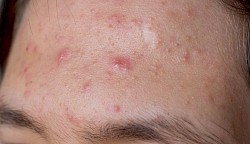Acne / Rosacea
ACNE DURING ADOLESCENSE IS LIKE ROSACEA IN LATER YEARS
Pimples, pustules, and redness everyone knows these problems from puberty - some of us less, some of us more. If, however, acne shows later in life, it is probably rosacea and not a relapse from acne during early years of life. Both forms - Acne and Rosacea – can be treated.

Acne
Acne, medically known as acne vulgaris, is a typical skin problem in teenagers. Girls usually show blemishes marking the acne earlier than boys do. However, boys are affected by more severe types of acne. In some cases, the problem can last up to the age of 40 sometimes even up to 60 years of age. The main factors responsible for the occurrence of acne can be androgenic hormones that lead to an increased sebum production; an increased keratinization at the exit of the sebaceous gland (to which the hair follicles are attached), bacteria living on the skin contaminating and infecting the plugged follicles, causing papules, pustules, nodules or cysts.
There are different types of acne. Depending on how many comedones, pustules, nodules, and cysts are present, and whether these are open or closed. Each type requires a different treatment. Light acne will be treated purely with topical medicines (ointments and cleansers); the more severe types of acne are treated with a combination of topical (skin-based) and oral medicines, such as antibiotics or vitamin A acid preparations. Regular cleansing, a so-called acne cleaning therapy should accompany the treatment. A skin care / or makeup consultation will ideally be included in the therapy.
Rosacea
Rosacea is a chronic disease of unknown cause, most often occurring in the fourth or fifth decade of life. Usually it is associated with flushing, persistent redness, vasodilatation, papules, and pustules especially in the middle facial area. The sex distribution is about the same. Triggering factors are hot and spicy foods, alcohol, and extreme fluctuations of temperature.
Rosacea is mainly categorized into three stages I-III:
Stage I only redness Stage II with pustules, papules and edema Stage III with phymas (sebaceous growths).
Depending on the stage, it is treated by purely treating it externally with
topical creams and pastes in Stage I, additional antibiotics in Stage II and in some cases (Stage III), the treatment is combined with vitamin A acid supplements, surgery or laser treatments are required.
A medically assisted cosmetic treatment with a deep cleansing mask and oxygen, followed by a rosacea pressure massage is beneficial in all cases.
